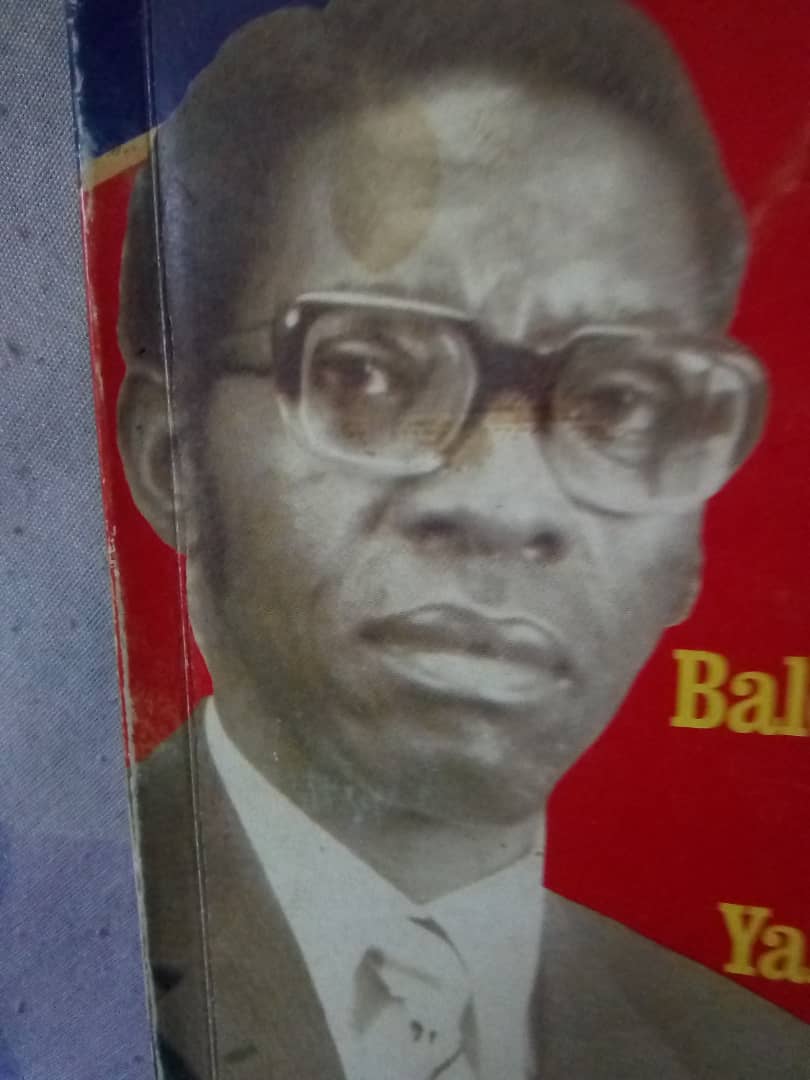Columns
Between Next-of-Kin, Letter of Administration, and Will

Between Next-of-Kin, Letter of Administration, and Will
By: Balami Lazarus
I write this piece not as a lawyer but as a supposedly layman, as this so-called legal professional called some of us. Family inheritance cases are among the most annoying litigations as far as I am concerned, where brothers flesh and blood engage each other on the estate left behind by their father with shame and consideration, and in some cases they go diabolical in order to claim and have possession of the estate of the deceased. I have seen and witnessed such on many occasions. Inheritance matters, land, and money have always been the motives behind family disagreements, feuds, and legal battles. Like money, which constitutes a major motive for crime among men, so does inheritance. Therefore, my self-development in law has given me some reasonable insight into what this caption is all about.
Next-of-Kin put on any document by parents or guardians, the bearer is not and shall not expressly be the heir-at – Law except and until proven that he is the only biological and legitimate child of whoever is the deceased. But to most people, in their ignorant thoughts, the bearer mentioned as next-of – kin will automatically inherit the estate of the deceased. It is legally wrong. Are you aware that one of the busiest areas of human traffic on the high court premises is the Probate Office? The traffic there is a crossroads for the applications seeking and requesting a Letter of Administration, which is only granted by the laws of the Federation of Nigeria through the office of the Probate Judge. To obtain such a sensitive legal document is tedious because it involves physical input and paper work by those in need of such a document—a letter of administration.
To nib these issues or matters of next-of-kin, a letter of administration is needed in order to claim the estate and have ownership of the properties left behind by the deceased. The only legal way out of this tough and thorny situation is to have a will written and signed by the testator, including his witnesses. And that such document is legally binding and can be executed by the person mentioned as the administrator of the testator’s will. Therefore, a will as a legal document is seen in the eye of the law not only as a written legal document but as the testator speaking in the presence of his family members and the law. Thus, there is no denying the fact that Will is over and above, far beyond Next-of – Kin and Letter of Administration, despite the fact that it can be challenged in a court of competent jurisdiction.
However, such cases are very rare. In Nigeria, most of her citizens are not aware of the importance and legal weight of will, for it is expressed expressly in an itemized manner, which spelled out willingly how the deceased wanted his estate to be managed and executed. I hereby advise men and women to begin to think of writing their wills because a will is a divider or sorter of matters arising from such a case as it may be.
Balami, a Publisher/Columnist: 08036779290
Between Next-of-Kin, Letter of Administration, and Will
Columns
Aspirations: A Compass for a Purposeful Journey of Life

Aspirations: A Compass for a Purposeful Journey of Life
By: Harmony Shimbura
A blueprint for a purposeful journey, the human experience is often defined not by where we are looking, but by having aspirations, a compass of purposeful life, and an act of claiming agency over one’s future.
My life’s aspirations are not merely a list of goals or a collection of ‘bucket list’ items. It is a living philosophy, a commitment to growth, connection, and the relentless pursuit of a life lived with intention. They are threads woven together for personal values and to give back to your community.
I believed the core of aspirations should be a desire for perpetual evolution. And I also believe that the moment we stop learning is the moment we stop breathing. Therefore, one of my primary goals is to remain a lifelong student where learning is a continuous process.
I aspire to deepen my understanding of the world through diverse perspectives, whether it is through traveling to places where knowledge is obtained by listening or observations, as is the case with the traditional Cherokee ways of learning.
I constantly challenge my own biases, spiritually and mentally. I aspire to reach the state of equilibrium where my peace is not dependent on external circumstances.
Do you know that aspirations transcend titles and salary brackets? Moreover, my true ambition is practical impact. I want to be engaged in work that I feel is the extension of my soul in it at whichever level. I also
I believe that work should be a contribution to the collective good of humanity.
As a young lady, I am on the self-push to achieve a level of mastery in my chosen field where my intuition is as sharp as my skills. I want to be known not just for what I did, but for how I did it with integrity, excellence, and a collaborative spirit.
Most of us neglect the vessel that carries us through life, but I aspire to treat my body with the respect it deserves. My aspirations for health are not about vanity but for sanity in purity.
These aspirations are not a destination I will one day reach; they are the fuel for a lifelong journey.
Harmony Shimbura writes from Zaria. 07033886918
Aspirations: A Compass for a Purposeful Journey of Life
Columns
Once upon a time, Plato College Sharam was a leader in academic excellence and discipline among schools in Nigeria

Once upon a time, Plato College Sharam was a leader in academic excellence and discipline among schools in Nigeria
By: Balami Lazarus
This article is dedicated to the living and dead. My teachers at Sharam, the 1978 intakes. For my wonderful classmates at Plato College. And for those before me, nice to have you as schoolmates.
I will use the “I” and “we” pronouns interchangeably because I was there as a student one cold morning of September 1978, where I spent two and a half academic sessions and left in 1980, leaving behind good and competitive classmates.
We of the 1978 intakes came from different parts of the country, from places like Yola, Lagos, Maiduguri, and Sokoto, and from other towns and cities as teenagers—boys and girls.
We that came from the city of Jos, few knew each other, while many for the first time. But Plato brought us together as students in Sharam to drink from the fountains of knowledge and discipline provided by Plato College Sharam near Kabwir in the Kanki Local Government Area of Plateau State. This came through Dr. Samuila Ndayako of blessed memory.
Similarly, classrooms, dormitories, and group work, assignments, and games were the cause of saving punishment that marked the beginning of my friendships with boys like Nash John Wash Pam, Jolomi David Amogoriye, Yau Dangana, Ismail Abdul, Thomas Owmeri, Gbenga (Kaduna), Kenneth Anosike, Edna Menta, and a few other students. I hope believing is well with them.
When I met with a few of them recently, it was a flashback of nostalgia of our days at Plato College Sharam as boys and girls full of life and dreams. Plato was a place to remember for two reasons, whether you like it or not: character and learning through academic excellence and discipline that you cannot take away. “One of the best-performing schools in the whole country in the West African School Certificate Examination (WASCE) for many years running.” Records as follows: 1979 to 1986: 100%; 1990: 100%. From 1994 to 1995, 100% was also achieved. And in 1997, 100% was made.
Sharam had never had it below average. The few of us that left for other schools manifested the academic training we got at Plato, where we were able to redeem it in character and learning.
Plato College Sharam is a co-educational institution established and owned by Dr. Samuila Ndayako, who was the Rector of the school. It came into existence on the 29th of September 1973 as Yakubu Gowon College but was later changed to Plato College in 1975 due to the circumstances surrounding General Yakubu Gowon in the year 1975. Political/military historians and journalists will know better of what took place.
The late Dr. Samuila Ndayako has left an indelible mark on the history of education in Nigeria. He was the first individual to start a private secondary school in the then North Central State, present Kaduna State, known as Balewa Memorial College at Samaru-Zonkwa, in 1967-1st April 1972, when the government took over mission schools and others from their rightful owners. Besides, he was also the first Northerner to
established a private secondary school. Equally one among the early individual proprietors of
private schools in Nigeria.
Sharam was a place for high moral and academic standards where you are expected to behave well. It opened our eyes to excellent academic performances, which regimented our minds for excellence. Plato during our days is where failure is not tolerated, even as a neighbor talks less as a co-tenant. Therefore, Plato College was the walkway for excellent performances for Platonians of Sharam.
It was where I learned the differences between discipline and punishment and understood that when discipline fails, you have no option other than to apply punishment. Here I learned of beneficial punishments that benefit all students and the school.
Plato College provided us with equal opportunities of a school environment as students. An environment where you are carried along and treated like any other student.
It was in Sharam that I understood the meaning of physical and mental work with its endless dividends. For many of us, it has become part of us to this day. Our Rector has always said it loud and clear that “no student I will train will end up useless.”
We were taught respect and its abundant benefits. As a co-educational institution of learning, we (the boys) are made to show respect and care and treat the girls with love. And we considered them anytime, anywhere as our sisters, because we were also taught to be responsible as future men and leaders.
At Sharam, obedience to school rules and regulations is a must. In fact, the military environment will bow to Plato College during our time.
Notwithstanding, Plato College had her challenges during our time, like extreme cold weather and water and electricity. Our seniors were strict on rules and regulations; some are bullies. However, every student, boy or girl, is made to have senior students as school fathers or mothers to guide and assist him or her from time to time.
What I had also learned personally from the life of Dr. Samuila Ndayako are honesty, boldness, fearlessness, and perseverance.
My school father was Senior Dung Peter, a kindhearted and brilliant student. Who has assisted and guided me to understand why I was in Sharam? I appreciate you.
Balami, Publisher/Columnist 08036779290
Once upon a time, Plato College Sharam was a leader in academic excellence and discipline among schools in Nigeria
Columns
Women and Money: Why Men Keep Money Away From Their Partners

Women and Money: Why Men Keep Money Away From Their Partners
By: Balami Lazarus
I was contemplating two words as language of use in this article: “hiding” and “keeping.” Having carefully settled for keeping simply means to protect or safeguard what rightfully belongs to you, like money, the subject of the work. With this in mind, I deemed it fit to progress with the writing.
In folktales, songs and stories, sayings and proverbs, money has been mentioned long before now, either in a good or bad light. But most times in the latter. Therefore, money has always been the bone of contention in relationships of different shades—individuals, lovers, and spouses—that sometimes breed brawls in a family setting.
Men are known to be the head of families and providers of necessary and basic needs of their families. Men toil and sweat with challenges and risks to legitimately provide for their families, where money plays a major role in meeting the family needs at all times.
Men not only engaged in providing, but the burden and totality of his family responsibilities rested on him. Therefore, to meet up with the family responsibilities, married men are cautious and frugal in spending their money on things that are not necessary, unlike most women out there, who spend money on wants, deliberately refusing to separate wants from needs. And these spendings of theirs can wake the dead from their peaceful rest.
The song of Dr. Mamman Shata, ‘kashi kudi ta hayan mai kyau,’ threw my mind to the wisdom of my late father, who used to caution us, his children, on spending our money on wants. Some never took him seriously, but today I am among those that saw meanings in that.
Few women are wealth creators; equally, some few among them do spend money on needs. I have observed over time as a young man and as a husband that most women are careless in spending money. They spend to belong, meaning for wants and things that are in vogue for mere appearance to announce the presence.
Because of their excessive demands, spending money on wants is their life investment spread in chattels that have no secondhand value.
Women’s attitudes towards money have made their spouses keep their hard-earned money away from them. It has come to a time where, after discharging their basic family responsibilities, men closed the chapter of money/spending.
The moment some wives see their husbands with money, that is when a long list of wants rears its ugly head in place of needs. Women are highly extravagant with vengeance when it comes to spending that they don’t earn or make by their efforts; in such a situation, you are a spectator. The worst of such is common in the relationships among young adults.
And as a man, if you are not spending for your spouse on her endless wants, you are, without a second thought, considered stingy, uncaring, local, conservative, and not romantic.
Many of them thought their wants were rights that must be fulfilled at all times, not knowing that those are not core family needs and responsibilities.
Balami, a Publisher/Columnist, 08036779290.
Women and Money: Why Men Keep Money Away From Their Partners
-

 News2 years ago
News2 years agoRoger Federer’s Shock as DNA Results Reveal Myla and Charlene Are Not His Biological Children
-

 Opinions4 years ago
Opinions4 years agoTHE PLIGHT OF FARIDA
-

 News8 months ago
News8 months agoFAILED COUP IN BURKINA FASO: HOW TRAORÉ NARROWLY ESCAPED ASSASSINATION PLOT AMID FOREIGN INTERFERENCE CLAIMS
-

 Opinions4 years ago
Opinions4 years agoPOLICE CHARGE ROOMS, A MINTING PRESS
-

 News2 years ago
News2 years agoEYN: Rev. Billi, Distortion of History, and The Living Tamarind Tree
-

 ACADEMICS2 years ago
ACADEMICS2 years agoA History of Biu” (2015) and The Lingering Bura-Pabir Question (1)
-

 Columns2 years ago
Columns2 years agoArmy University Biu: There is certain interest, but certainly not from Borno.
-

 Opinions2 years ago
Opinions2 years agoTinubu,Shettima: The epidemic of economic, insecurity in Nigeria





